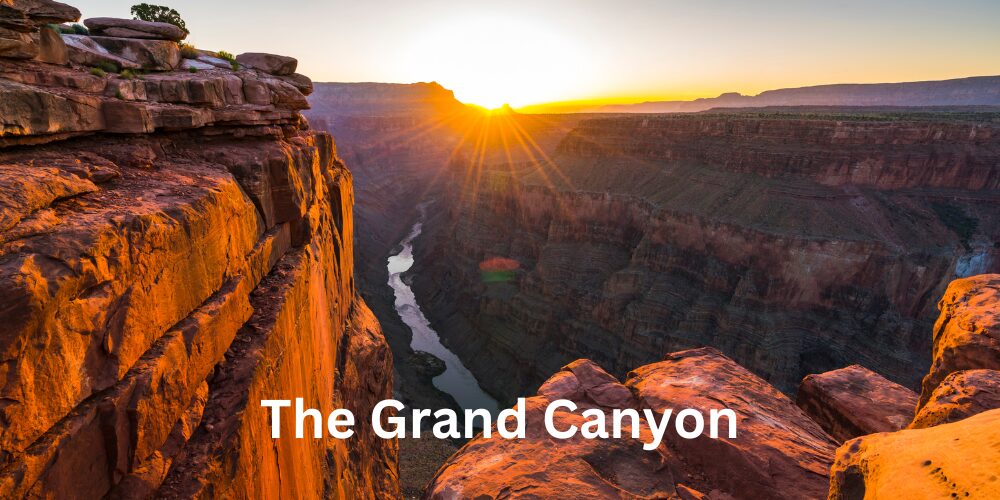The Grand Canyon: A Timeless Wonder Carved by Nature
Few places on Earth stir your soul quite like the Grand Canyon. Towering cliffs, endless horizons, and layer upon layer of ancient rock tell a story that spans nearly two billion years. This colossal chasm is one of the Seven Natural Wonders of the World. It is also one of the most visited and loved destinations in the United States. Stretching 277 miles long, up to 18 miles wide, and over a mile deep, the Grand Canyon is a landscape of extremes—where silence can be deafening, beauty overwhelming, and time itself feels suspended.

A Landscape Forged by Time
The story of the Grand Canyon is amazing.It was Formed primarily by the erosive power of the Colorado River over the course of millions of years. The canyon exposes a cross-section of the Earth’s crust like no other place. Each rock layer is a chapter in Earth’s history, some dating back nearly two billion years. The Vishnu Schist is among the oldest exposed rocks on the planet. It forms the base of the canyon and speaks to a time when this region was a seabed under crushing pressure.
But it wasn’t just water that sculpted the canyon’s jagged ridges and sweeping amphitheaters. Volcanic activity, tectonic uplift, and the persistent battering of wind and ice played their parts in shaping this epic panorama. Today, standing at any of the canyon’s overlooks feels like gazing into the ancient past—and into the very heart of the Earth.
Click here for a Niagara Falls day trip from Manhattan by helicopter.
A Feast for the Senses
For first-time visitors, nothing prepares you for that first look over the edge. Whether you arrive at sunrise, when the cliffs blush pink and orange, or during the golden hour of sunset, when shadows dance across the depths, the sight is staggering. The Grand Canyon seems too vast, too intricate, too perfect to be real. And yet, there it is—utterly silent, wildly alive, and stretching beyond comprehension.
The South Rim, home to the most iconic viewpoints like Mather Point, Yavapai Observation Station, and Desert View, offers jaw-dropping vistas with easy access. You can walk along the Rim Trail, a mostly flat path that hugs the edge for over 13 miles, delivering new perspectives with every step. Mule deer might cross your path and ravens might soar overhead. If you’re lucky, you’ll spot a California condor gliding gracefully over the abyss.
Click here for a full day New York to Montauk fishing trip with private helicopter.
If you venture to the less-crowded North Rim, you’ll find a quieter, cooler, and more forested environment. It has viewpoints like Bright Angel Point and Cape Royal offering equally dramatic views. Though it’s only about 10 miles as the crow flies from the South Rim, the North Rim feels like an entirely different world—and it’s open only from mid-May to mid-October due to heavy snowfall.

Adventure Below the Rim
Seeing the Grand Canyon from the top is breathtaking, but descending into it is a transformative experience. The canyon reveals itself differently at every level. Trails like the Bright Angel and South Kaibab allow hikers to venture below the rim, where every switchback offers a fresh perspective, and the walls begin to close in, towering above you like cathedrals.
The South Kaibab Trail, with its open ridgelines and sweeping views, is a popular day hike. Even a short walk to Ooh Aah Point (Yes, that’s its real name) offers a taste of the inner canyon’s grandeur. For the more ambitious, a trek to Phantom Ranch at the canyon’s bottom is a bucket-list adventure. Nestled beside the Colorado River, Phantom Ranch is a rustic oasis reachable only by foot, mule, or raft.
Click here for a full day Grand Canyon tour and hike.
Camping below the rim, watching the stars emerge in a sky unpolluted by city lights, and waking to the echo of canyon wrens is something few forget. But it’s not for the unprepared—temperatures can swing wildly, and the return hike is always more strenuous than the descent.
Rafting the Colorado
Another way to truly experience the canyon is from the river that carved it. A rafting trip down the Colorado River offers a completely different perspective—one of intimacy and immersion. Whitewater rapids like Lava Falls and Crystal can get the adrenaline pumping, but there are also long stretches of calm, where red walls rise thousands of feet above you, slot canyons invite exploration, and waterfalls spill over hidden grottos.
Click here for a white water rafting tour of the Grand Canyon.
Trips range from a few days to over two weeks, and while they require planning (permits or guided tours), they’re among the most exciting and rewarding ways to see the canyon’s rugged beauty.

A Cultural Landscape
Long before it became a tourist destination, the Grand Canyon was home to Indigenous peoples who still live and thrive in the region today. The Havasupai, Hopi, Navajo, Hualapai, and several other groups have deep spiritual and historical ties to the canyon. Their stories, songs, and sacred places are woven into the landscape.
The village of Supai, in the canyon’s western reaches, is accessible only by foot, horseback, or helicopter. Here, the Havasupai people live in one of the most remote communities in the continental U.S., near the famous turquoise waterfalls of Havasu Creek. Visiting this part of the canyon offers a powerful reminder that the Grand Canyon is not just a wonder of geology—it’s a living, cultural landscape.
Click here for a private 3 day spiritual aerial safari.
Preserving the Wonder
Grand Canyon National Park was established in 1919, but the fight to protect its beauty began much earlier. Visionaries like John Wesley Powell, who led early expeditions down the river, and President Theodore Roosevelt, who visited in 1903, were instrumental in its conservation. Today, over six million people visit the park each year. Preserving its fragile ecosystems and sacred spaces has never been more important.
The canyon faces threats—from climate change affecting its water sources to increased tourism pressure and proposed developments on its rim. Park rangers, scientists, and tribal leaders continue to work together to ensure that this ancient marvel remains intact for generations to come.
Click here for a luxury car tour experience.
Why It Matters
The Grand Canyon is more than just a hole in the ground—it’s a place where human insignificance meets Earth’s infinite wisdom. Whether you’re looking for natural beauty, to reconnect with nature, challenge yourself physically, or simply find stillness, the canyon delivers.
To stand at the edge of the Grand Canyon is to feel both the weight of history and the lightness of awe. It’s a reminder of nature’s power, patience, and artistry. And once you’ve seen it, you’ll never quite see the world the same way again.
